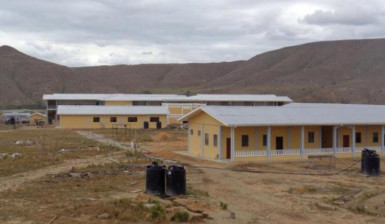Almost €1.8 million in European Union (EU) funding for the proposed Kato Hydropower Project expired in February.
Now, pending sourcing of funding for the project, government has decided to install a hybrid solar-diesel system at the $1 billion Kato school complex that was built as one of the pre-conditions for the investment.
Stabroek News reported last week that over three years after government secured nearly half a billion dollars in EU funding to build the hydropower plant at Kato, in Region Eight, the project had still to get off the ground. The $1 billion school complex built as a pre-condition for the investment is almost complete. The school was envisaged to be the main consumer of power supplied by the plant.

Minister of Public Infrastructure David Patterson told Stabroek News recently that while over 30 manufacturing and development companies in hydropower development in EU/ACP countries were contacted on the tender, only three bids were received. Two local companies, BK International and Dynamics Engineering, and one foreign company, Farmex Technologies placed bids. However, all were above budget—going as high as 2.5 times the proposed sum—and they were deemed not technically compliant.
“Unsuccessful efforts were made to the EU for an extension of the project implementation period and waiver of the EU rules of origin principle, resulting in the EU funding of the project expiring February 2015,” Patterson said. He added that it has since been decided to install a hybrid solar-diesel system in the interim, pending the sourcing of funding for the hydropower component of the project. This request is to be included in the 2015 budget, which is to be presented tomorrow. This is to be implemented by the Ministry of Education with technical support from the Hinterland Electrification Company Inc (HECI), Patterson said.
He revealed that of the EU’s funding, only €18,138 was used for the review of the project design and cost and recommendations following the failure of the tender. Government of Guyana funding, which was to construct the transmission line, was not touched but funds available to the HECI were utilised for surveying and other preparatory works for the transmission line, he said.
According to Patterson, the future of the project is dependent on funding from concessionary sources and/or a Public/Private Partnership with Government’s commitment to such an arrangement with the developer. He said that should government remain committed to the project, maybe in the interim, a statement to this effect should be made public.
He said that the Ministry of Education has informed that the school complex construction is 98% completed based on the last engineer’s report, dated August 4, 2015.
In January 2012, the EU had announced that the total cost of the project was expected to be €2.4 million (approximately $615 million), with the EU contributing €1.8 million (approximately $460 million) under the 10th European Development Fund (EDF), while the Guyana Government would contribute €613,949 (approximately $154 million). Construction of the hydropower plant was scheduled to commence at the end of 2013 but nothing happened.
However, the secondary school was built. “The secondary school is foreseen to be the main electricity consumer and therefore as such forms the basis for feasibility of the investment,” the EU had said.
Kares Engineering had won the contract for the construction of the school with a bid of $691,972,139. In April, the Government Information Agency (GINA) had reported that the school was near completion. Former Regional Executive Officer (REO) for Region Eight Ronald Harsawack had previously said that the main structure will cost $780M but the cost of furnishing; lighting, fencing, and security may take the final figure to around $1B.
The opening of the school has been rescheduled to January next year.
When announcing the project, the EU had said that as part of the government’s broader hinterland electrification programme, the system would comprise a 330-kilowatt micro-hydropower station with its primary energy source being the 36 metres head waterfall in the Chiung River in the vicinity of Kato village. “Sufficient generating capacity for electrical services is to be provided to a secondary school complex to be constructed by the Ministry of Education, existing government buildings, such as the nursery/primary schools, the guest house, the police outpost, medical facilities, and school dormitories, and to also facilitate agro processing and commercial farming. Furthermore the system will provide electricity to Paramakatoi through a 16 km transmission line which forms part of the intervention,” the statement said.
The hydropower project was divided into two lots. Lot One dealt with the design and construction of the hydropower plant and Lot Two dealt with the design and construction of the irrigation infrastructure. Work was scheduled to begin at the end of 2013 and last for 20 months.
Stabroek News was told that hydropower consulting company Sven Homscheid Hydropower + RE Consulting was providing services to the Guyana Government for the project. According to the company, it provided services to the project since its initial stage and was the employer’s engineer to the Government of Guyana during the tender and contracting phase for the works.
It said that the services provided to date comprise project identification study review, supervision of the feasibility study, assistance for application for EU grant financing, establishment of the tender documents and assistance during the tendering process and assistance during contract negotiations.
The former government had been pursuing a mini-hydropower facility for the area for some time, with particular emphasis on the potential for expanding crop production.




